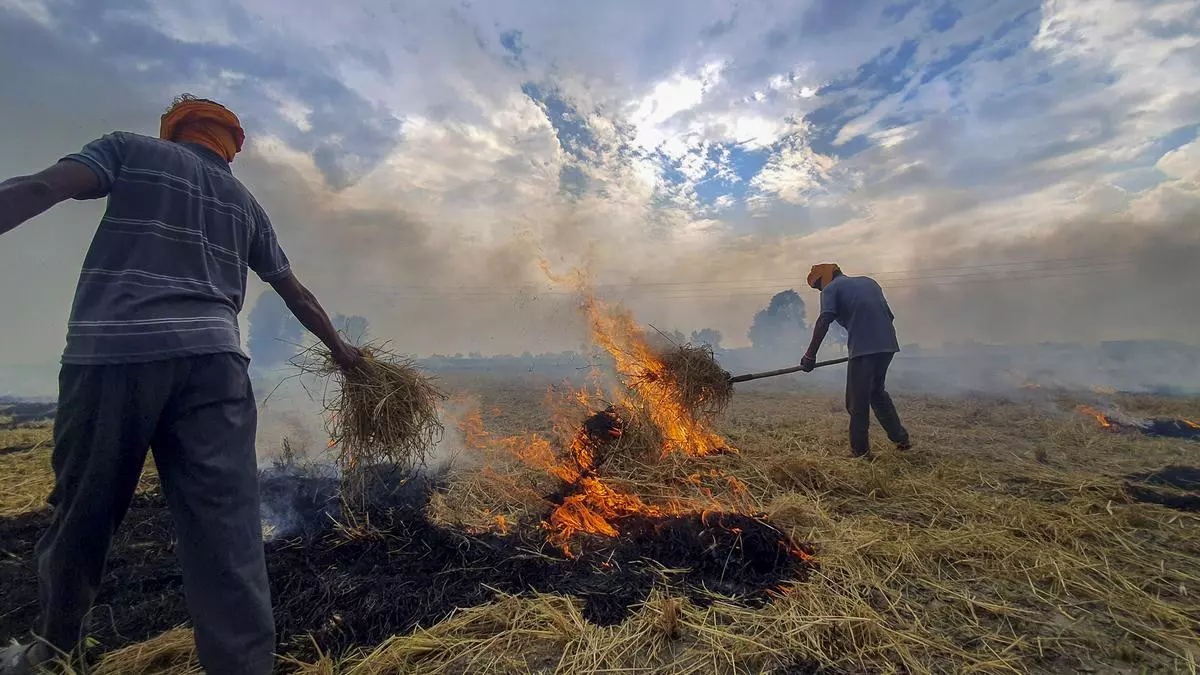Stubble burning incidents fall 17%, but air quality in NCR turns poor
The overall incidents of stubble burning have fallen by 17 per cent, with 1,875 cases reported since paddy harvesting began on September 15.
However, despite Punjab, Rajasthan and Madhya Pradesh together reporting a 39 per cent drop in number of burning incidents, the air quality in the national capital region (NCR) turned ‘poor’ prompting Delhi government to immediately ban production, storage, sale, and use of firecrackers until January 1.
Also, the government has invoked Stage – I of GRAP.
In an order issued Monday evening, the Commission for Air Quality Management (CAQM) said that the actions prescribed in the guidelines must be implemented from Tuesday morning 8.00 a.m. in the NCR.
The 27-point action plan to be enforced under Stage I of the Graded Action Response Plan (GRAP) include ban on coal/firewood as fuel in Tandoors in hotels, restaurants and open eateries, strict vigilance and enforcement of PUC norms for vehicles and impounding of visibly polluting vehicles.
The burning incidents of crop residues in Haryana and Uttar Pradesh together have 37 per cent jump at 866 this year during September 15-October 13, as against 633 in the year-ago period, according to satellite data collated by IARI’s Consortium for Research on Agroecosystem Monitoring and Modeling from Space (CREAMS).
On the other hand, Punjab, Rajasthan and Madhya Pradesh together have 1,003 burning incidents during September 15-October 13, as against 1,636 in the year-ago period.
Amritsar, Tarn Taran, Patiala and Sangrur in Punjab, and Kaithal, Kurukshetra, Ambala, Karnal, Jind and Sonipat are the major districts where maximum number of stubble burning incidents are detected by satellites.
The paddy acreage (including Basmati) in Punjab this year increased to 32.4 lakh hectares (lh) from 31.8 lh year-ago while in Haryana it rose to 16.4 lh from 15.2 lh, mainly because of a lot of cotton farmers shifted to the cereal crop.
In Uttar Pradesh, Aligarh, Sambhal, Mathura and Barabanki whereas in Rajasthan Sri Ganganagar and Hanumangarh districts have maximum cases of burning incidents.
“There has been a spurt in incidents from October 10 and in the past four days alone 70 per cent of the total cases has been reported,” said a scientist involved in monitoring of the stubble burning data.
Meanwhile, according to the Central Pollution Control Board bulletin, the Air Quality Index (AQI), in Delhi on Monday at 4.00 p.m. was 234 and continued under ‘poor’ category for the second consecutive day, in which PM 10 and PM 2.5 are the prominent pollutants.
In the national capital territory of Delhi, the AQI was 180 (moderate) in both Faridabad and Gurugram, 271 (poor) in Ghaziabad and 268 (poor) in Noida.
Out of 248 places across the country where the CPCB monitored the air quality, Greater Noida (in Uttar Pradesh) had the worst index at 274.
According to CPCB, AQI in the range of 0-50 is considered ‘good’, 51-100 is ‘satisfactory’, 101-200 is ‘moderate’, 201-300 is ‘poor’, 301-400 is ‘very poor’ and 401-500 is categorised as ‘severe’.
The Delhi government on Monday imposed a ban with immediate effect on the production, storage, sale, and use of all kinds of firecrackers until January 1.
Seeking support of the residents, Delhi’s environment minister Gopal Rai through a social media post said, “In view of the increasing pollution in winter, a ban has been imposed…and we request the cooperation of all Delhites.” He cited dust pollution, transport emissions, and biomass burning as the three main sources of pollution in the city.
The CAQM on October 12 said that officials would face prosecution if they fail to enforce stubble burning regulations in the NCR, Punjab, Haryana, Rajasthan and UP.
It has authorised Deputy Commissioners/District Collectors/District Magistrates to file a complaint, prosecute before a magistrate in case of inaction of officials responsible for enforcement of elimination of stubble burning in their jurisdiction.
